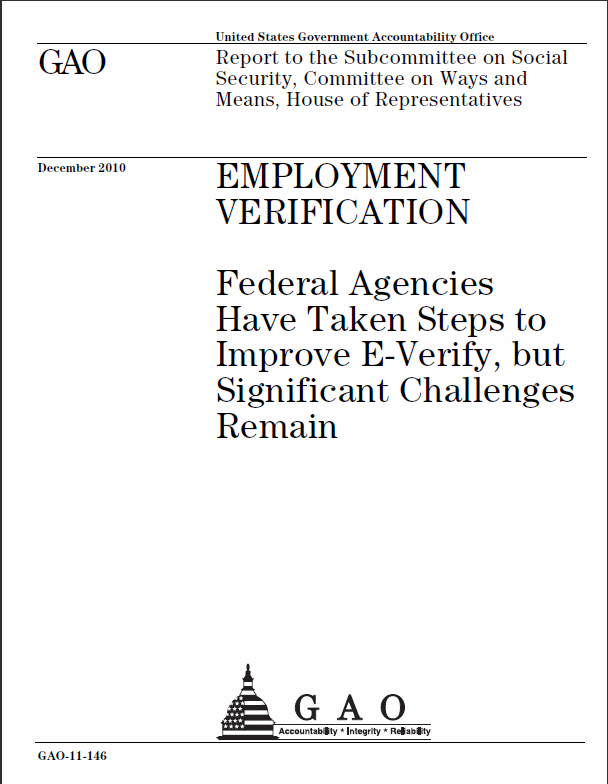Recently the United States Government Accountability Office (GAO) published an extensive report that assesses key components of the E-Verify program. In similar fashion to a report published in June 2008, the GAO’s findings describe the E-Verify system’s strengths and weaknesses, as well as sheds light on possible future changes to the program. You can access a full copy of the 81 page report from the GAO’s website here.
 Overall, the GAO reports that E-Verify made significant improvements that reduced the number of erroneous Tentative Nonconfirmations (TNC). However, false-positive TNCs still occur, which can disproportionally affect foreign national employees that may in turn lead to an appearance of discrimination. Furthermore, the E-Verify system continues to be vulnerable to employer fraud and identity theft. The report concludes with a series of recommendations, including several ways to further reduce erroneous TNCs, suggestions for improved education efforts to help employers comply with E-Verify, as well as a call for an honest evaluation by both the SSA and DHS to ensure each agency accurately assess the resources required to fund and operate E-Verify should its use be significantly increased if Congress were to pass an expanded federal mandate.
Overall, the GAO reports that E-Verify made significant improvements that reduced the number of erroneous Tentative Nonconfirmations (TNC). However, false-positive TNCs still occur, which can disproportionally affect foreign national employees that may in turn lead to an appearance of discrimination. Furthermore, the E-Verify system continues to be vulnerable to employer fraud and identity theft. The report concludes with a series of recommendations, including several ways to further reduce erroneous TNCs, suggestions for improved education efforts to help employers comply with E-Verify, as well as a call for an honest evaluation by both the SSA and DHS to ensure each agency accurately assess the resources required to fund and operate E-Verify should its use be significantly increased if Congress were to pass an expanded federal mandate.
In addition to the GAO’s extensive analysis of the E-Verify program, there are several hints as to what stakeholders may see from E-Verify in the future. For example, the GAO describes a Driver’s License pilot program that is planned to get underway in 2011 (p. 27). The program apparently seeks to incorporate Driver’s License data into E-Verify, which could be used to confirm the license number and expiration date when one is presented as a List B identify document in Section 2 of the Form I-9. However, state privacy laws may interfere with an expansion of this program. The report states that the pilot program does NOT incorporate the use of photographs, so as for now it seems unlikely that E-verify photomatching will expand to include driver’s licenses. The report also describes plans to allow individuals to “lock” their Social Security number within E-Verify in an effort to reduce identify fraud (p. 27).
In the section describing the challenges faced for resolving erroneous TNC and FNCs, the GAO alludes to a very interesting and significant potential change to the TNC process (p. 36). Although there are relatively few details, the report describes how in 2012 E-Verify officials plan on simplifying the TNC notice and referral letters by combining them; employees will receive one letter that serves as the TNC notification as well a referral to the agency to resolve the TNC. Currently, employers are instructed to review a TNC notice letter with the employee, and only if the employee chooses to contest the TNC is the employer required to review a separate TNC referral letter with the employee.
While it remains to be seen if any of these potential changes to E-Verify will be realized, with more than 16 million queries ran by more than 243,000 employers in fiscal year 2010, this much is certain: E-Verify is here to stay.